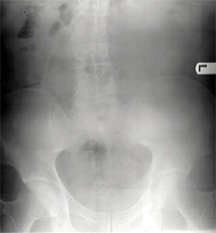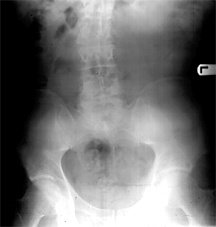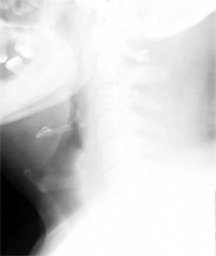
|
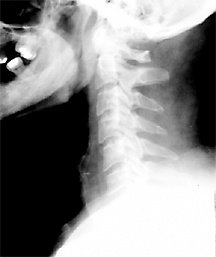
|
Compare the clarity and detail of this standard X-ray (left) with the same image enhanced using digital radiography (right). | |
Dynamic Chiropractic asked LCCW President Gerard Clum, DC, about the benefits of the new system and how it will be utilized at the college.
| Using the DR technology, any standard X-ray (left) can be enhanced in any fashion. | |
Q: Dr.
A: Digital radiography (DR) is an amazing technology. The advantages of using this system to capture skeletal images begin with the patient and a dramatic reduction in exposure to radiation. Exposure factors can be reduced by up to one-third utilizing a DR system.
Q: But X-ray is still X-ray; how is the reduction in radiation accomplished?
A: There are two key elements associated with reducing exposure using this approach. Traditional film radiography tends to require higher factors that essentially overexpose the film, which is then developed up to the point of obtaining an image. An underexposed film cannot be affected by developing, but an overexposed film can be developed up to the image. This type of overexposure is not an intentional approach; it is basically how X-ray is used. In the DR environment, lower factors are used to create the image, and a computer program is used to bring the image to the desired image quality.
The second means of reducing X-ray exposure involves a dramatic reduction in retakes. Films that are underexposed or significantly overexposed must be retaken. Using DR technology, these types of errors can be corrected by the software system, and a retake isn't needed.
The bottom line is simple: If you get the body part in front of the bucky and it doesn't move, you are almost always going to get an image that can be enhanced to an appropriate film.
Q: What are the advantages of this technology for the practicing chiropractor?
A: The patient safety issues are great, but the chiropractor gets so many other positive benefits from the technology. Imagine never buying any more X-ray film; never having to purchase replacement chemicals for an X-ray processor; never losing another film; and never having to spare one additional square foot for film storage. These are not pie-in-the-sky possible advantages; they are real and immediate.
Q: Aside from the safety factors and the cost savings associated with consumables, does digital radiography provide greater clinical utility?
A: In comparison to the aspects we have already touched on, the clinical utility DR provides is out of sight! Imagine looking at a film and wishing the contrast was a bit better, or that a given structure was a bit more exposed and visible - voilˆ: two clicks of a mouse and the film is exactly what you wanted. Imagine looking at a structure and wishing it were more easily visualized - two clicks and that osteophyte you were looking at now occupies an entire computer screen. The icing on the cake is that you can save as many enhanced images as you want - an enlargement of the atlantoaxial area, some lipping on a lateral image, or any image - enhanced anyway you want.
Q: What does a chiropractor do when someone else needs a copy of the images, but the person requesting the images doesn't use digital radiography?
A: This is where the technology moves from being useful to being downright fun. Say an insurance company has a question about an image; you can print the image to plain paper (the penny-a-page stuff) and e-mail it to the adjuster, or you could burn it to a CD and send it along with your report. Now, here's the best part: The software you use with the film is embedded with each image, so the person who gets the film only needs a computer that can access e-mail or a CD.
Q: Let's get down to affordability: Is this technology within reach of the average chiropractor?
A: An office that is taking four or five film sets a day can close to a wash in terms of costs, and all the utilitarian aspects we've talked about come with the deal. If you are building or remodeling an office, and you factor in the cost savings of not having to construct and equip a darkroom, the savings become more obvious and more immediate.
Q: What changes need to be made to the X-ray machine itself to use the DR technology?
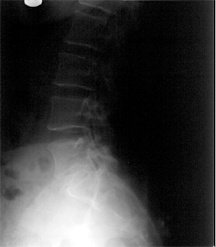
|
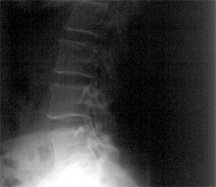
|
A standard X-ray (left) and the enhanced version (right). | |
A: Almost none. Basically, the only changes that are made on the production or machine side involve your technique factors. You use cassettes, just like you do now, but instead of placing film in the cassette, a digital plate is housed in the cassette. Instead of heading off to the darkroom with your cassettes, you simply open them, take out the digital cards and run them through a photocopy-like reader, and the images are captured and processed through the software. At that point, you enhance the image to the extent you desire and go from there.
Q: Do you plan on making this resource available to chiropractors in private practice?
A: LCCW has provided local chiropractors with imaging-related support, from simply taking the images to providing over-read services on films they have taken. With the availability of DR, we are able to provide chiropractors with the same services, but rather than sending the patient back to them with a film envelope, we send a CD.
There is one other exciting opportunity we can offer through this technology. If you have taken films, send them to the college we can then scan them into our system and give you much of the benefit of images that were initially captured through DR. One great advantage to this approach is that we can take a less-than-ideal film and provide you with a more desirable enhanced image. This is particularly useful when you are likely to go to court with a particular set of images.
Q: A new graduate is probably unable to afford this level of practice sophistication; how are you addressing that aspect of DR implementation?
A: You are absolutely right. At this point, we have added DR to our curriculum, rather than replacing film-based imaging with this technology. Our students continue to be trained in darkroom procedures and traditional film radiography management.
Q: How do you plan to use this technology in the day-to-day presentation of the curriculum at Life West?
A: This is an exciting development for our faculty and students. Any image we capture digitally can be used on a de-identified basis in the classroom. Let's assume we come across a unique set of images, or perhaps dozens of them over a given term. We can copy these images to a CD, attach radiology reports to them, hyperlink instructional materials and create low-cost, high-quality instructional media for each student in a particular class.
Dynamic Chiropractic editorial staff members research, investigate and write articles for the publication on an ongoing basis. To contact the Editorial Department or submit an article of your own for consideration, email
.





